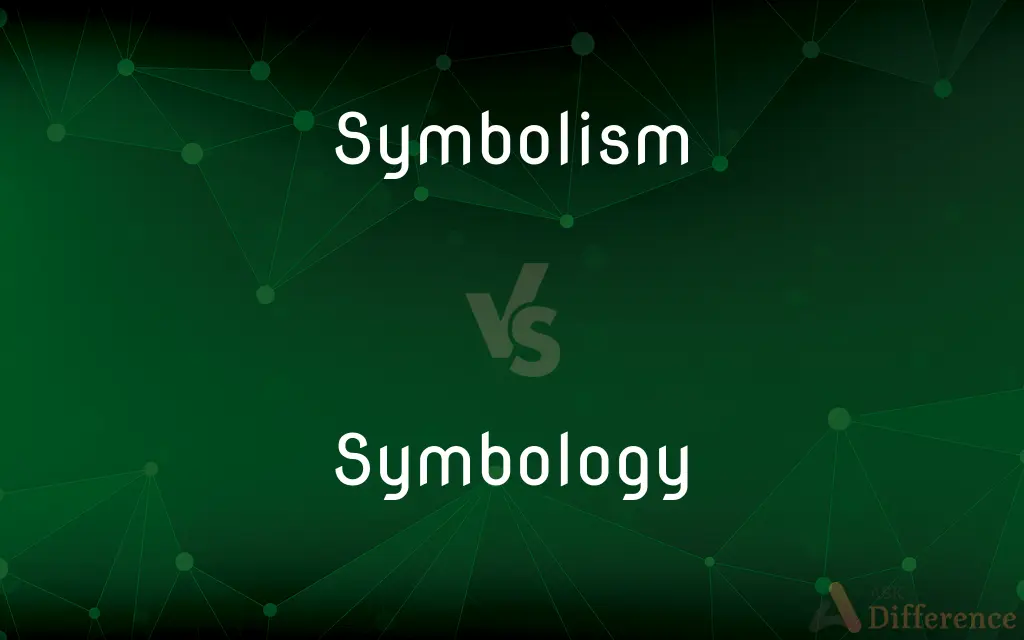Symbolism vs. Symbology — What's the Difference?
By Maham Liaqat & Fiza Rafique — Updated on March 8, 2024
Symbolism is the use of symbols to represent ideas or qualities, often in literature, art, and religion, whereas symbology is the study or use of symbols, focusing on their meaning and significance in various contexts.

Difference Between Symbolism and Symbology
Table of Contents
ADVERTISEMENT
Key Differences
Symbolism involves employing symbols—objects, figures, colors, or sounds—to imply ideas, concepts, or emotions deeper than their literal meaning. It's a pervasive technique in literature, art, and religious texts, where a dove might symbolize peace, or the color red might represent love or anger. Symbology, on the other hand, is the systematic study or interpretation of symbols. It delves into understanding how symbols convey meanings and how these meanings evolve across different cultures and contexts.
While symbolism serves as a creative method to enrich narratives, evoke emotions, or convey complex ideas through indirect suggestion, symbology focuses on the analysis and interpretation of these symbols. For instance, the study of religious iconography or corporate logos falls within the realm of symbology, examining how symbols are crafted, perceived, and understood by audiences or adherents. Conversely, an author might use symbolism to imbue their work with a layer of meaning without explicitly stating it, relying on the audience's ability to interpret these cues.
Symbolism allows for the expression of abstract ideas in a tangible form, making complex or intangible concepts accessible and relatable. It relies on shared cultural or emotional understandings to communicate effectively. Symbology, however, approaches symbols from an academic or analytical perspective, categorizing symbols, exploring their origins, and studying their effects on society and individual psychology.
In practical terms, symbolism is a tool used by creators and communicators to add depth and resonance to their work. It is subjective and open to interpretation, allowing for multiple meanings or readings of the same symbol. Symbology is more objective, seeking to catalog symbols and decode their meanings within specific frameworks or systems of thought, whether in semiotics, psychology, or cultural studies.
The distinction between symbolism and symbology emphasizes the difference between using symbols as a means of artistic or rhetorical expression and studying symbols as a distinct field of knowledge. Symbolism enhances storytelling and artistic expression, enriching narratives with layers of meaning. Symbology, meanwhile, equips scholars, designers, and thinkers with the tools to understand and utilize symbols effectively in various domains, from branding to religious practice.
ADVERTISEMENT
Comparison Chart
Definition
Use of symbols to imply deeper meanings.
Study or use of symbols and their meanings.
Primary Focus
Expressing ideas or qualities through symbols.
Analyzing and interpreting symbols.
Contexts
Literature, art, religion.
Cultural studies, semiotics, branding.
Objective
To convey complex ideas indirectly.
To understand and classify symbol meanings.
Nature
Creative and interpretive.
Analytical and systematic.
Compare with Definitions
Symbolism
Employing symbols to convey deeper meanings.
In literature, a journey often symbolizes personal growth.
Symbology
The study of symbolic representations.
Analyzing the symbology of religious icons in medieval art.
Symbolism
Communicates complex ideas subtly.
The color green symbolizing envy or nature in different contexts.
Symbology
Examines symbols across cultures and disciplines.
Symbology explores how the swastika's meaning varies globally.
Symbolism
Utilizes imagery to evoke emotions or concepts.
A broken mirror in a story might symbolize shattered expectations.
Symbology
Focuses on the evolution of symbols.
The study of how the heart shape became associated with love.
Symbolism
Interpreted based on cultural or personal contexts.
The eagle symbolizing freedom in American iconography.
Symbology
Aids in the design and interpretation of symbols.
Using symbology to create an effective brand emblem.
Symbolism
Enriches narratives by adding layers of meaning.
The use of spring to symbolize rebirth in a poem.
Symbology
Involves decoding symbols in various contexts.
Understanding corporate logos' impact through symbology.
Symbolism
The practice of representing things by means of symbols or of attributing symbolic meanings or significance to objects, events, or relationships.
Symbology
The study or interpretation of symbols or symbolism.
Symbolism
A system of symbols or representations.
Symbology
The use of symbols.
Symbolism
A symbolic meaning or representation.
Symbology
(uncountable) The study or use of symbols.
Symbolism
Revelation or suggestion of intangible conditions or truths by artistic invention.
Symbology
(countable) An encoding scheme, particularly for barcodes.
Symbolism
Symbolism The movement, theory, or practice of the late 19th-century Symbolists.
Symbology
The art of expressing by symbols.
Symbolism
Representation of a concept through symbols or underlying meanings of objects or qualities.
Symbolism
(obsolete) A combining together of parts or ingredients.
Symbolism
The act of symbolizing, or the state of being symbolized; as, symbolism in Christian art is the representation of truth, virtues, vices, etc., by emblematic colors, signs, and forms.
Symbolism
A system of symbols or representations.
Symbolism
The practice of using symbols, or the system of notation developed thereby.
Symbolism
The science of creeds; symbolics.
Symbolism
A system of symbols and symbolic representations
Symbolism
The practice of investing things with symbolic meaning
Symbolism
An artistic movement in the late 19th century that tried to express abstract or mystical ideas through the symbolic use of images
Common Curiosities
What is symbolism used for?
Symbolism is used to convey complex ideas, emotions, or themes indirectly through symbols, enriching narratives or artistic expressions with deeper meanings.
Can a symbol have multiple meanings?
Yes, symbols can carry multiple meanings, depending on the context and cultural background of both the creator and the audience.
Can symbology change over time?
Yes, the meanings of symbols can evolve over time as cultural contexts and societal values shift, making symbology a dynamic field of study.
Is symbolism only found in literature and art?
While commonly associated with literature and art, symbolism can be found in various forms of communication, including film, music, and everyday objects.
How does one study symbology?
Studying symbology involves examining historical, cultural, and social contexts of symbols, often through academic disciplines like semiotics, anthropology, or cultural studies.
Why is understanding symbolism important in literature?
Understanding symbolism in literature is crucial for grasping the deeper layers of meaning within a text, allowing readers to appreciate the nuances and complexities of the narrative.
What does symbology study?
Symbology studies symbols, their meanings, origins, and their use across different cultures and contexts, aiming to understand how symbols convey specific ideas or values.
How do symbolism and symbology differ in their approach?
Symbolism is a creative and interpretive approach that uses symbols to convey meaning, while symbology is an analytical and systematic study of symbols and their meanings.
What role does the audience play in interpreting symbolism?
The audience's cultural background, personal experiences, and knowledge significantly influence how they interpret symbolism, making it a subjective experience.
Can an individual create their own symbolism?
Yes, individuals can create their own symbolism in artistic or personal expressions, though its effectiveness depends on shared understanding or explanation.
Share Your Discovery

Previous Comparison
Fortitude vs. Fidelity
Next Comparison
Outcome vs. EventAuthor Spotlight
Written by
Maham LiaqatCo-written by
Fiza RafiqueFiza Rafique is a skilled content writer at AskDifference.com, where she meticulously refines and enhances written pieces. Drawing from her vast editorial expertise, Fiza ensures clarity, accuracy, and precision in every article. Passionate about language, she continually seeks to elevate the quality of content for readers worldwide.












































